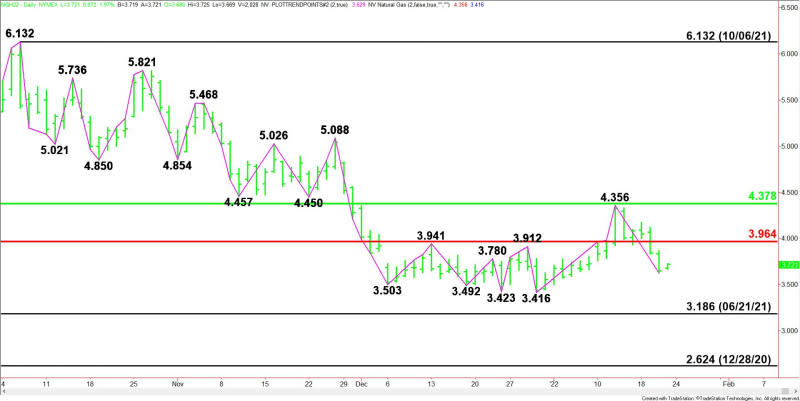Nat Gas Plunge Suggests Enough Supply to Meet Winter Needs
Natural gas futures are trading flat early Friday after tumbling more than 5% to a two-week low the previous session on forecasts for less cold and lower heating demand over the next two weeks than previously expected.
Sellers were relentless, ignoring a government report that showed last week’s storage withdrawal was bigger than usual and despite a drop in U.S. gas output to its lowest level in four months as a regional cold snap caused well freeze-offs in Texas and several other producing states.
At 06:30 GMT, March natural gas futures are trading $3.758, up $0.109 or +2.99%.
Don’t Give Up on Winter Yet
According to Reuters, “Even though the latest forecast called for less cold for the rest of January, traders noted the weather would still remain colder than normal this week and next and daily U.S. gas demand will likely reach a record high on Friday.
That serves as a reminder of the last time gas demand was expected to reach record highs before last winter’s February freeze.
Analysts expect the cold will boost heating demand and force utilities to withdraw massive amounts of gas from storage over the next few weeks, causing overall inventories to slip below the five-year average for the first time since mid-December.
Last winter, next-day gas jumped to record highs in several parts of the country – gaining over 1,100% on February 12 at the Waha hub in West Texas – as a winter storm left millions without power and heat for days after freezing gas wells and pipes in Texas and other U.S. central states.”
Energy Information Administration Weekly Storage Report
The Energy Information Administration (EIA) reported on Thursday that domestic natural-gas supplies fell by 206 billion cubic feet (Bcf) for the week-ended January 14. That compared with the average decline of 193 Bcf forecast by analysts polled by S&P Global Platts, which pegged the five-year average supply fall for the period at 167 Bcf.
Natural Gas Intelligence (NGI) reported ahead of the EIA report, estimates were wide ranging and as steep as 250 Bcf. A Reuters poll of 16 analysts, whose estimates ranged from withdrawals of 153 Bcf to 250 Bcf, landed at a median pull of 196 Bcf. The Wall Street Journal said its poll found analysts on average expecting a withdrawal of 201 Bcf.
Total stocks now stand at 2.810 trillion cubic feet (Tcf), down 226 Bcf from a year ago, but 33 Bcf above the five-year average, the government said.
Short-Term Outlook
The fundamental and technical pictures are in sync with both pointing lower. This typically means any bullish surprises from the weather are likely to create new shorting opportunities.
Fundamentally, the EIA report showed continued tightness in the supply/demand balance, given the biting cold across the country. However, the price action seems to be showing that traders remain confident that supplies are plentiful enough to meet winter heating needs – even with a string of 200-plus Bcf withdrawals on tap amid the record cold.

Technically, March natural gas futures are trading on the weak side of its 52-week retracement zone at $3.964 – $4.378, making this area resistance.
Look for the downside bias to continue as long as the market remains below this area with the June 21, 2021 main bottom at $3.186 the next target.
For a look at all of today’s economic events, check out our economic calendar.
This article was originally posted on FX Empire

